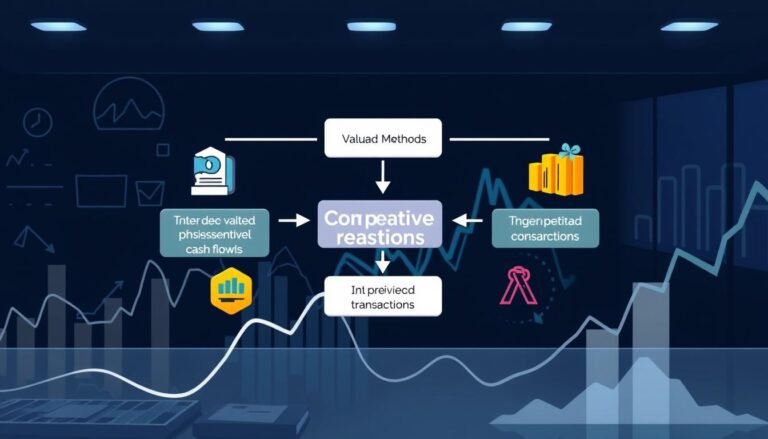The Complete Guide to Mergers and Acquisitions (M&A) for Senior Leaders
Are you ready to tackle the world of M&A? Or will your next big move hit a snag like many others have?
Mergers and acquisitions are key for growing companies. But, they need more than just a clever plan. “The Complete Guide to Mergers and Acquisitions” by Timothy Galpin and Mark Herndon has been a go-to since 1999. It gives senior leaders the tools and insights they need to succeed in M&A.
In 2023, over 50,000 M&A deals were done in the U.S. This shows how crucial it is to have skilled leaders for these big projects.
The book covers everything from starting a deal to integrating it after it’s done. It warns about how bad integration can ruin plans and waste money. It uses examples like Disney’s Pixar deal and Sprint’s Nextel mistake to teach leaders.
Key Takeaways
- Understanding the full M&A lifecycle is critical for success.
- Effective integration management is essential to meet financial and strategic goals.
- The guide provides actionable steps to capture cost and revenue synergies.
- Real-world examples illustrate both successful and cautionary M&A stories.
- Trends indicate increasing M&A activities, particularly in technology and healthcare.
- High-interest rates and geopolitical uncertainty are current challenges in M&A.
- Senior leadership involvement is pivotal in navigating complex M&A processes.
Introduction to Mergers and Acquisitions (M&A)
Mergers and Acquisitions (M&A) are a key strategy for business growth. They involve combining companies or assets. This is crucial for restructuring and forming strategic alliances.
What is M&A?
M&A basics cover different types of deals where companies join forces. A merger creates a new entity from two companies. An acquisition happens when one company buys another. These moves help expand markets, achieve scale, and gain a competitive edge.
The Importance of M&A for Corporate Growth
M&A is vital for corporate growth. These deals can expand markets, improve supply chains, and enhance competitiveness. For example, Microsoft bought LinkedIn for $26.2 billion in 2016. This move aimed to boost business networking.
| Company | Deal Value (Year) | Strategic Purpose |
|---|---|---|
| Microsoft-LinkedIn | $26.2 Billion (2016) | Expand Market Influence |
| Amazon-Whole Foods | $13.7 Billion (2017) | Diversify into Grocery Market |
| Facebook-Instagram | $1 Billion (2012) | Acquire New Technology and Audience |
Strategic Reasons to Pursue M&A
Mergers and acquisitions (M&A) are powerful strategies. They offer substantial benefits to companies. These include market expansion and enhancing competitive advantage.
Accelerating Market Expansion
Mergers help companies quickly enter new markets. They also broaden their customer base. For example, Vodafone’s acquisition of Turkey’s Telcim allowed it to enter new regions.
Coca-Cola’s acquisition of Monster Energy in 2008 aimed to boost growth in the energy drink segment. This shows how M&A can help companies grow in different markets.
Enhancing Competitive Advantages
M&A is also a way to enhance competitive advantages. LVMH’s acquisition of multiple luxury brands shows how it can dominate the market. It also enriches the brand’s reputation.
Disney’s acquisition of Pixar not only gave it access to innovative animation technology. It also solidified Disney’s position as a leader in entertainment.
Achieving Supply Chain Efficiencies
Supply chain integration in M&A can lead to cost savings and operational efficiencies. IKEA’s acquisition of Romanian forests in 2015 is a good example. It shows how companies can control their supply chain better through vertical integration.
The merger of Exxon and Mobil in 1998 is another example. It resulted in both revenue and cost synergies. This improved their overall performance.
The M&A Lifecycle: Key Stages and Components
The M&A lifecycle is complex but crucial for corporate growth. It involves stages from initial planning to final integration. Each stage needs careful strategies and precise execution.
Formulate
The first stage is deal formulation. It starts with setting strategic goals and finding the right target companies. Almost all M&A deals begin with an information memorandum to check market interest. Confidentiality is ensured with Non-Disclosure Agreements (NDAs).
Locate
Finding the right merger targets is the next step. This involves a detailed search and assessment. Advisors help in this process, looking at both cost savings and revenue increases.
Investigate
After finding targets, a thorough investigation begins. This includes checking financial, legal, and operational aspects. Due diligence covers many areas, and agreements are made to protect both sides.
Negotiate
Negotiation is the next stage. It involves intense talks to agree on terms. Deals often include post-merger requirements and price adjustments. Good negotiation skills are key to success.
Integrate
The last stage is post-merger integration. It involves merging operations and aligning cultures. This ensures the new entity works well together. Effective integration is crucial for success.
The M&A process is complex and can take months to years. Companies use M&A firms to manage each stage. Knowing the M&A lifecycle helps leaders maximize value and achieve their goals.
| Stage | Key Activities | Best Practices |
|---|---|---|
| Formulate | Identify strategic objectives, create an information memorandum, sign NDAs. | Focus on clear strategic goals and confidential transactions. |
| Locate | Search for and assess potential targets. | Leverage professional advisors for thorough market analysis. |
| Investigate | Conduct comprehensive due diligence. | Engage in exhaustive due diligence to cover all relevant areas. |
| Negotiate | Discuss terms, finalize legal agreements. | Efficiently negotiate terms to ensure favorable outcomes and manage risks. |
| Integrate | Merge operations, align cultures. | Focus on effective integration strategies for seamless transitions. |
Valuation Techniques in M&A
Valuation techniques are key in M&A deals. They help guide talks and shape the final deal. Senior leaders need to know different M&A valuation methods to make sure deals are good and valuable after they’re done.
These methods include market-based, income-based, and asset-based approaches. Each gives a unique view of a company’s worth.
- Market-Based Valuation Methods: Techniques like Comparable Companies Analysis (Comps) and Precedent Transactions Analysis are used a lot. Comps look at similar public companies to guess a target’s value. Precedent Transactions check past deals to see market prices.
- Income-Based Valuation Methods: The Discounted Cash Flow (DCF) analysis looks at future cash flows. It discounts them to today’s value using a rate. This method shows a company’s worth by looking at future cash flows.
- Asset-Based Valuation Methods: Adjusted Book Value, Liquidation Value, and Replacement Cost are used to value tangible assets. These methods look at physical assets, giving a clear picture of the company’s worth without intangible factors.
Also, the control premium is a big deal in M&A. It’s usually more than 50% above fair value to get full control. This premium shows the value of having full control over the company’s future.
Goodwill is another key part of M&A financial analysis. It’s the extra value buyers pay for things like reputation and loyal customers. Intangible assets, like patents and trademarks, also add a lot to a company’s value.
“Goodwill and intangible assets are crucial in M&A, showing non-quantifiable values like reputation and market leadership.”— Expert Insights
When valuing a business, it’s important to look at financial statements. You need to understand the company’s capital structure, financial performance, and trends. Adjusting financial info, like EBITDA, helps show a company’s real profitability.
Industry multiples, like the EBITDA multiple, can simplify valuing companies. But, using different acquisition valuation strategies is key for a detailed and accurate valuation. Knowing about synergies, barriers to entry, and growth potential is also important.
In the next decade, 4.5 million businesses, worth over $10 trillion, will change hands through M&A. With 10,000 baby boomers turning 65 every day, many businesses will be sold or merged.
The Due Diligence Process
More than 60% of CEOs plan to make at least one acquisition in the next three years. This shows a big increase in M&A activity. Due diligence is key to successful acquisitions. It checks the target’s finances, laws, and operations.
It helps both sides understand each other’s good and bad points. This makes decisions better and reduces risks. The process looks at finances, culture, and laws to fully check the target company.
Financial Due Diligence
Financial due diligence checks if a target company is financially healthy. It looks at financial statements, cash flow, and risks. This helps find out the company’s financial strengths and weaknesses.
It also checks for hidden debts and makes sure financial information is correct. Good financial due diligence reduces surprises and makes deals more likely to succeed.
Cultural and Human Capital Due Diligence
Checking if companies fit culturally is important. It looks at employee skills, structure, and culture. This ensures a smooth merge and better teamwork.
It also checks HR policies and employee contracts. This helps avoid problems when companies join together.
Legal and Regulatory Due Diligence
Legal checks are crucial in M&A. It reviews the target’s legal documents and compliance. This finds legal risks and makes sure the company follows laws.
By checking legal matters, buyers protect their investments. This makes the acquisition smooth and legal.
| Aspect | Key Focus |
|---|---|
| Financial Due Diligence | Assessing financial health, reviewing statements, identifying risks |
| Cultural and Human Capital Due Diligence | Evaluating cultural fit, human capital assessment, HR policies |
| Legal and Regulatory Due Diligence | Reviewing legal documents, ensuring regulatory compliance |
Structuring the Deal: Asset Sale vs. Stock Sale
Senior leaders must decide between asset sales and stock sales in M&A deals. Knowing the differences is key for making smart choices.
An asset sale lets the buyer pick certain assets and liabilities. It’s popular for deals under $50 million because of tax benefits and lower legal risks. Buyers can write off the assets for tax savings. Also, asset sales include essential business assets, but the seller keeps accounts receivable and working capital.
Stock sales, however, mean buying the whole company, including all assets and liabilities. This is common for big companies. It’s good for getting unique assets that can’t be sold separately. But, there are risks like unknown liabilities. Buyers often start new companies to avoid these risks.
| Aspect | Asset Sale | Stock Sale |
|---|---|---|
| Buyer Preference | Tax advantages, lower legal risk | Complete control of entity, less time to close |
| Seller Ownership | Retains entity post-transaction | Transfers entire entity |
| Transaction Size | More common in smaller deals | More common in larger deals |
| Control Over Assets | Buyer chooses specific assets | Buyer assumes all assets and liabilities |
The IRC 338(h)(10) election is a middle option. It treats a stock sale like an asset purchase for taxes. This is useful when you need to buy stock but want tax benefits of an asset sale.
Choosing between an asset sale and a stock sale depends on many factors. These include tax implications, liability concerns, and the deal’s specific needs. These factors help pick the best M&A structure for strategic goals.
Regulatory Compliance in M&A
Regulatory compliance is key in M&A. Senior leaders must be ready to handle complex rules. This ensures the deal follows the law. Knowing these rules well can avoid delays and legal problems.
Understanding Regulatory Requirements
M&A deals face many laws and rules. In the U.S., both state and federal governments must approve mergers. For deals outside the country, getting approval from CFIUS is crucial.
It’s also important to follow specific laws, like HIPAA for healthcare deals. This ensures the deal meets all necessary standards.
Common Regulatory Challenges
Dealing with regulatory challenges in M&A is tough. One big issue is the time it takes to prepare for regulations, which is at least six months. Doing thorough compliance checks is essential to find any issues that could affect the deal.
Common problems include checking intellectual property, product technology, contracts, and risks. Also, getting approval from the target company’s board and shareholders is needed.
| Key M&A Compliance Areas | Details |
|---|---|
| Regulatory Preparation Time | Minimum of six months |
| Financial Statements and Reports | Quality of Earning (QoE) report by an independent expert is recommended |
| Legal Guidance | Experienced legal advisors for handling negotiation issues |
| Seller Protections | Exclusions in seller representations and warranties |
| Escrows and Holdbacks | Typically up to 10% of the purchase price |
| Working Capital Considerations | Determined at closing, seller prepares an opening balance sheet |
| Dual Jurisdiction Approvals | Needed from state and federal governments in the U.S. |
| International Approvals | CFIUS approval for overseas deals |
| Sector-Specific Laws | Compliance with laws like HIPAA for healthcare M&A |
Starting early to tackle regulatory challenges helps M&A deals go smoothly. This leads to a better transition and a strong market position for the new company.
Financing the Deal
Getting through an M&A deal needs careful financial planning and structuring. The right financing can greatly affect the success of a merger or acquisition. It’s important to pick the best option.
Choosing the Right Financing Options
M&A deal financing has different types, each with its own pros and cons. The choice depends on the deal’s details, like the companies involved and the economy. The main ways to finance M&A deals are:
- Cash Financing: Used by companies with lots of cash, it’s simple but can lead to taxes on capital gains.
- Debt Financing: It lets target shareholders delay taxes and can boost a company’s finances. But, it also raises the acquirer’s debt.
- Stock Swaps: Acquirers might use new stock as payment. This shows confidence in the company but can be complex and costly.
Importance of Financial Planning
Good financial planning is key for a merger’s long-term success. It involves looking at financing costs, tax effects, and making sure there’s enough money for operations after the deal. Companies must check their finances and forecasts to make smart choices.
- Taxation Considerations: The tax effects of different financing methods need careful thought. For example, triangular mergers can lower taxes.
- Post-Merger Integration Costs: Planning should include the costs of merging the companies, like updating systems and changing staff.
- Shareholder Impact: Keeping shareholders happy is crucial, especially when more than 50% need to approve the deal.
Private M&A deals usually start at $20 million. Different structures, like reverse takeovers and triangular mergers, have their own financial effects. Knowing these and picking the right financing options can help achieve long-term success and stability after a merger or acquisition.
| Financing Option | Advantages | Disadvantages |
|---|---|---|
| Cash | Direct and simple, immediate ownership | Triggers capital gains taxes, depletes cash reserves |
| Debt | Defers taxation, leverages borrowing | Increases debt load, interest obligations |
| Stock Swaps | Preserves cash, can improve debt rating | Complex, potential for share dilution, market perception |
Risk Management in M&A
Mergers and acquisitions can lead to big growth for companies. But, they also bring risks. It’s key to manage these risks well to succeed. Knowing the common risks in mergers and how to reduce them helps companies grow stronger.
Identifying Common Risks
First, it’s important to know the usual risks in M&A deals. These risks include:
- Financial Risks: Paying too much, hidden debts, or unstable income.
- Operational Risks: Problems with operations, integration issues, and losing key staff.
- Legal and Regulatory Risks: Breaking laws, unresolved legal issues.
- Cultural Risks: Differences in company culture that can harm morale and productivity.
A McKinsey study shows finance leaders are playing a bigger role in companies. They oversee more and help shape growth plans. It’s vital to manage these risks well for M&A success.
Mitigating Risk Factors
After spotting risks, it’s time to find ways to lessen them. Good strategies include:
- Due Diligence: Do deep checks on finances, laws, operations, and culture to find issues early.
- Valuation Accuracy: Use smart ways to value deals to avoid overpaying. Tools like Discounted Cash Flow (DCF) and Comparables Analysis work well.
- Clear Communication: Keep all involved parties informed to avoid misunderstandings.
- Expert Consultation: Get advice from financial experts and risk managers for unbiased views.
- Ongoing Monitoring: Keep an eye on risks after the deal and adjust plans as needed.
Modern bank risk management tools and digital solutions help predict and solve problems. Using these technologies in your M&A risk management plan can make things smoother and better.
Good communication and detailed integration plans are key. Clear talks build trust and help everyone work together. A solid integration plan tackles cultural and operational issues early, making the transition smoother.
Here’s a quick look at how to reduce risks:
| Risk Type | Mitigation Strategy |
|---|---|
| Financial Risks | Accurate valuation, expert consultation, and ongoing monitoring |
| Operational Risks | Thorough due diligence, maintaining key talent, clear communication |
| Legal and Regulatory Risks | Compliance with regulations, regular legal audits |
| Cultural Risks | Comprehensive integration planning, addressing cultural mismatches |
Post-Merger Integration Strategies
The post-merger integration phase is key to achieving the new entity’s vision. It involves planning, executing, and communicating the merger effectively. This ensures a smooth transition.
Integration Planning
The first step in M&A integration is planning. It turns strategic goals into real plans. The State of M&A Integration Effectiveness Survey shows that good planning reduces disruptions and sets the stage for success.
Practical planning includes:
- Reviewing the target company’s financial, operational, and legal aspects
- Building a skilled integration team with representatives from various departments
- Outlining steps to merge functions while setting goals to measure progress and success
Execution and Monitoring
Executing merger strategies is crucial. M&A research shows that aligning processes and leveraging strengths boosts efficiency. Key actions include:
- Strategically planning and assigning roles to integrate teams effectively
- Regular monitoring to track progress using Key Performance Indicators (KPIs)
- Mitigating risks by adjusting tactics based on real-time feedback and metrics
Communication Strategies
Effective M&A communication is vital for aligning stakeholders and ensuring a smooth integration. New studies highlight the importance of clear communication in merging cultures and managing change. Essential strategies include:
- Establishing strong communication channels for ongoing updates and alignment
- Ensuring all stakeholders are informed of changes and progress
- Promoting an open dialogue to address concerns and gather feedback
A thorough approach to integration planning, strategy execution, and communication is essential. It helps create a cohesive and efficient organization. This organization is ready to achieve long-term synergy and success.
People Dynamics and Cultural Integration
The role of cultural integration in M&A is huge, with 95 percent of executives seeing it as key to success. Companies that manage people well are more likely to meet their goals. By focusing on assessing cultural fit and managing transitions, leaders can create a smooth post-merger environment.
Assessing Cultural Compatibility
It’s important to have a clear plan when checking culture during mergers. You can use interviews, focus groups, and surveys to get a picture of the current culture. It’s vital for leaders to understand and agree on the cultural changes needed.
Leadership is crucial here, as they need to align and set a good example. This helps in making cultural changes work.
To integrate culture well, companies should define specific behaviors and practices. Cultural elements like vision and values should guide the desired behaviors. Both hard and soft measures are needed for real change.
Doing a cultural check before the merger is key. It helps spot challenges early and guides integration strategies.
| Cultural Integration Approaches | Key Focus Areas |
|---|---|
| Management Interviews | Leadership alignment and role modeling |
| Employee Focus Groups | Shared understanding of cultural shifts |
| Surveys | Assessing existing cultural landscape |
| Pre-M&A Cultural Assessment | Identifying cultural challenges early |
| Incremental Gains | Ensuring comprehensive cultural transformation |
Managing Workforce Transition
Good workforce transition management is key for a smooth integration. Identifying and training key employees can help spread cultural changes. Keeping things open and honest builds trust.
It’s important to keep an eye on progress during the merger. Reflecting on the process after the merger helps learn what worked and what didn’t.
Challenges like regional differences and work values can be tackled with an open and inclusive approach. A team from both sides helps monitor and integrate cultures effectively. Using tools like Prosci can help manage cultural differences and change.
By managing these dynamics well, companies can set the stage for a successful merger. They can meet both cultural and business goals.
The Role of Executive Leadership in M&A Success
Executive leadership is key in M&A success. Leaders must navigate change, build trust, and foster collaboration. This is crucial for mergers and acquisitions to thrive.
Leadership During Disruptive Change
Executive leadership is vital during disruptive changes. CEOs with M&A experience lead companies 35% more likely to succeed. They help manage risks and ensure a smooth transition.
Choosing the right leaders is not just about numbers. It’s about making informed decisions that align with the company’s new direction. Clear principles in leadership selection can boost the chances of keeping top leaders, preventing a 20% drop in shareholder value.
Building Trust and Collaboration
Building trust and collaboration is key to integration success. Strong leadership from both companies is crucial in 67% of successful M&A deals. Yet, only 44% of executives believe their companies manage cultural integration well.
Addressing cultural differences is essential. A clear integration strategy is vital for success, as 63% of executives agree. Investing in leadership development for M&A roles can increase integration success by 50%.
Gender diversity in leadership also plays a role. Companies with diverse leadership teams are 25% more likely to succeed in M&A. This shows the importance of diverse perspectives in building trust and collaboration.
Leadership retention at Company A highlighted the benefits of keeping existing leaders in place, while Company B’s approach of letting most counterparts go was less effective. A clear indication that transparent leadership selection is vital for retaining top talent post-merger.
In conclusion, executive leadership is crucial in M&A. It helps navigate change, build trust, and ensure collaboration. By focusing on these areas, organizations can increase their chances of successful integration and long-term success.
Insights and Lessons from Microsoft’s Acquisition of LinkedIn
The Microsoft LinkedIn acquisition analysis is a key M&A case study. It was the second-largest tech deal, worth $26.2 billion. It happened in February 2016 and was finished by December that year. It shows many lessons from M&A and successful acquisition insights.
Microsoft added 130,000 LinkedIn employees to its team. This move showed Microsoft’s plan to use LinkedIn to improve work across industries.
Studies by Deloitte Consulting found companies with inclusive talent practices do better. They make up to 30% more revenue per employee. Microsoft followed this by keeping LinkedIn’s identity while promoting teamwork.
The M&A decision took months, showing the need for careful planning and openness. Microsoft and LinkedIn considered employee feelings and agreements to keep everyone involved.
Microsoft and LinkedIn worked well together because of their shared values. Microsoft’s study found successful teams have purpose, identity, awareness, trust, and constructive tension.
Using Microsoft Teams was key in bringing the companies together. It helped improve work and unite different teams. This technology helped both companies work better together.
The Microsoft-LinkedIn deal is a great example in M&A. It offers important lessons and lessons from M&A for many industries.
Conclusion
In this guide, we’ve covered the key aspects of mergers and acquisitions (M&A) for senior leaders. We looked at how M&A helps businesses grow and the steps involved in the M&A process. This guide offers a detailed look at how to approach M&A.
We discussed the reasons for doing M&A, like increasing market share or improving supply chains. We also talked about the different ways to buy a company, including asset and stock acquisitions. Each step is important for gaining an M&A advantage.
Real-life examples, like Microsoft buying LinkedIn and Adidas merging with Reebok, showed how M&A can change a company. Leadership plays a big role in these changes. Leaders must guide through tough times, build trust, and integrate well to succeed.
Following the best practices for M&A, senior leaders can handle these challenges better. This leads to lasting growth and a stronger position in the market.
Source Links
- The Complete Guide to Mergers and Acquisitions
- Ultimate Guide to Mergers and Acquisitions in the Business World
- The Complete Guide to Mergers and Acquisitions
- Mergers and Acquisitions (M&A) | Complete Guide
- Mergers and Acquisitions (M&A): Types, Structures, and Valuations
- What are Mergers & Acquisitions (M&A): The Only Guide You Need
- 13 Reasons for Mergers & Acquisitions: Exploring M&A Motives | FirmRoom
- A blueprint for M&A success
- Mergers & Acquisitions – The 5 stages of an M&A transaction
- Mergers Acquisitions M&A Process
- Mergers and Acquisitions: M&A Law (a Complete Guide)
- 11 M&A Valuation Methods & Why Your Narrative Matters
- M&A Valuation Methods: Your Essential Guide with 7 Key Methods
- The Complete Guide to Understanding M&A Valuation Process – Succession Resource Group – Award-Winning M&A Experts
- Due Diligence in M&A Transactions [Process + Checklist]
- Due Diligence in Mergers and Acquisitions: Complete Overview
- M&A Basics | Asset vs. Stock Sale – Morgan & Westfield
- M&A Deal Structure | Asset v Stock Sale | OH IN KY
- M&A Deal Structure
- Guide to the Mergers & Acquisition (M&A) Process
- Regulatory Compliance In M&A: How To Ensure A Smooth Approval Process – Alejandro Cremades
- Mergers and Acquisitions | Complete Guide + M&A Financing from $5M
- How to Conduct an M&A Risk Assessment
- Strategic Risk Management in Mergers & Acquisitions
- Top 10 Merger and Acquisition Risks and How to Avoid Them
- Post-Merger Integration: A Complete Guide for the First-Time Buyer
- Organizational culture in mergers: Addressing the unseen forces
- How To Improve Your M&A Cultural Integration for Success
- Why a Winning Leadership Team Matters for M&A Strategy
- A CEO’s guide to the new challenges of M&A leadership
- The Importance of Leadership in M&A Transactions
- Microsoft is in: Six Strategies for LinkedIn’s continued success post-acquisition by Microsoft
- What I learned from Mergers and Acquisition Assignments at Microsoft
- Microsoft linkedin acquisition
- Ultimate Guide to Mergers & Acquisitions
- Mastering M&A Strategy: A Comprehensive Guide for Successful Mergers and Acquisitions








